Renewable energies: Powering a greener future
Last updated: 3.11.2022

To speed up the transition towards a climate-neutral economy and realise its commitments under the 2015 Paris Agreement, the European Commission has set ambitious goals. The 2030 Climate and Energy Framework provides the following minimum key targets to be met by the end of the decade:
- 55% reduction in greenhouse gas emissions (from 1990 levels)
- 32% share of renewable energy
- 32.5% improvement in energy efficiency
Given that the production and use of energy account for over 75% of the EU's greenhouse emissions, transitioning to greener energy is crucial. There are multiple European, national and regional initiatives to support these aims. The European Green Deal and the EU's Circular economy action plan are of central importance, especially to the longer term aim of carbon neutrality in the EU by 2050. Overall success will depend on a secure and affordable energy supply, a resilient and digitalised energy market and a focus on energy efficiency and renewable energy production.
Learn more
Read the recent joint study by the EPO and the International Energy Agency on Patents and the energy transition.
United Nations Sustainable Development Goals
Innovation in the field of renewable energies mainly supports progress towards United Nations Sustainable Development Goals:
- Solar energy

Solar energy technologies convert sunlight into electricity and heat. The amount of energy that continuously reaches the Earth from the sun is equivalent to over 10 000 times the world's total energy usage. Further technological advances are needed if we are to make the most of this renewable and widely available energy source.
Photovoltaics
Photovoltaic (PV) systems convert sunlight into electricity thanks to the photovoltaic effect, a physical and chemical phenomenon first demonstrated by French physicist Edmond Becquerel in 1839. In the 1950s, the first solar cells to be implemented were used in niche applications such as satellites. These cells had an energy conversion efficiency of around 6%. Today, most commercially available photovoltaic panels rely on monocrystalline or polycrystalline silicon-based technologies. These panels can achieve energy conversion efficiencies of around 23%.
Major advances continue in thin-film, multijunction, organic and bifacial solar cells, among others. Flexible and semi- or fully transparent panels are already commercially available and offer great potential too. They can be easily transported and flexibly integrated into buildings or even mobile devices. Photovoltaic systems continue to play a pivotal role in the energy transition, whether in huge power generation plants (both inland and on water) or in smaller distributed energy units for homes, devices and vehicles.
Although worldwide photovoltaic power generation more than tripled between 2015 and 2020, it accounted for just 3.1% of global electricity generation in 2020. However, new capacity is being added every year.
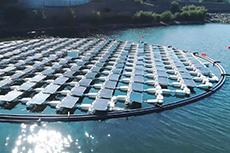
Thermal power plants
Other solar energy technologies include solar thermal power plants. These generate "concentrated solar power" by using mirrors to capture sunlight that then heats up fluid to generate steam and produce electricity. Meanwhile, solar thermal panels use the sun's energy to provide hot water to homes and industry.
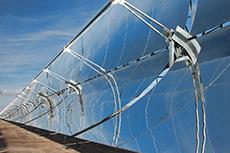
Discover inventors' stories
Several inventions by European Inventor Award finalists and winners have advanced the field of solar power technologies.

Nuno Correia, Carla Gomes and team
Together with their team, the engineers Nuno Correia and Carla Gomes have developed a floating solar farm platform that tracks the sun. Discover how Correia and Gomes’s path-breaking invention can increase the efficiency of photovoltaic panels.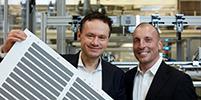
Henrik Lindström and Giovanni Fili
These two Swedish innovators have a dream that one day, every mobile device will be able to harvest its own energy from light. Learn how they are helping to make this dream a reality with their flexible solar cells for portable devices.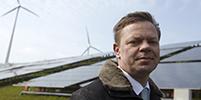
Jörg Horzel and team
When the physicist Jörg Horzel first started work in the field, photovoltaics was still in its infancy and there was no market for solar technology. He and his team achieved a major contribution to making solar cell production easier and cheaper.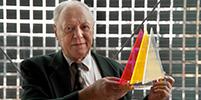
Adolf Goetzberger
The world's total solar cell production was at just 500 kilowatts when he started to round up support for solar energy in the mid-1970s. Today, the energy self-sufficient, zero-emissions house that Adolf Goetzberger’s research institute pioneered is replicated all over the world. Learn more about what drove this pioneer of solar energy conversion.Search patent information
Further solar energy inventions can be found in the Y02 classification scheme for climate change mitigation technologies:
- Hydropower and ocean energy

About 71% of the Earth's surface is covered by water, a huge potential source of renewable energy that can be harvested using various technologies - some of which are very old, some very new.
Hydropower (or hydroelectric power) is generated by converting the energy of flowing or falling water into electricity. The waterflow can be used to rotate a turbine, which in turn actuates an electrical generator that produces power. There are many different water turbine technologies. Large-scale projects use dams to generate electricity. Among the largest in the world is the Three Gorges Dam in central China, with 32 main turbines spanning the Yangtze River, each with a capacity of some 700 megawatts. Smaller scale units on rivers or waterfalls elsewhere may generate just a few kilowatt-hours.
Some hydroelectric power plants generate electricity during peak hours and then pump the water back at periods of low demand to repeat the cycle. This provides a valuable opportunity for such plants to "store" electricity from other more intermittent renewable energy sources. Excess wind power can, for example, be used to pump water upstream that can then be used as required.
Hydropower is the leading renewable energy technology by capacity and generation. In 2020, hydropower accounted for 17% of global energy generation, making it the third most significant energy source overall, after coal and natural gas. Its contribution is 55% greater than nuclear's and outstrips that of all the other renewable energy sources combined, including wind, solar photovoltaic, bioenergy and geothermal.
However, hydropower is usually restricted to freshwater areas. So what about all the salt water out there? Ocean energy technologies are the answer. They can be used to generate electricity from the tides (tidal range systems), subsea currents (tidal stream systems), natural temperature differences in oceans (ocean thermal energy conversion, or OTEC) and waves (wave energy convertors or WECs). However, most of these technologies are still at a relatively early stage of development. By the end of 2018, for example, only 243.4 megawatts capacity of ocean energy had been officially registered in EU member states.
Discover inventors' stories
Miroslav Sedláček
Discover how a myriad of previously untapped sources of hydropower, from ocean tides to small brooks, could be exploited using Miroslav Sedláček’s “rolling fluid turbine”.
Alexander Gorlov
Learn how the mechanical engineer Alexander Gorlov (1931-2016) modified the blades of his turbine by twisting them like strands of DNA, to create the helical turbine for power and propulsion systems.
Search patent information
Further hydropower and ocean energy inventions can be found in the Y02 classification scheme for climate change mitigation technologies:
- Wind energy

Wind power has been used to feed, transport and assist humanity since time immemorial, and continues to do so today. The windmills of Nashtifan, a village in northeast Iran, have been working for more than a millennium now! Modern onshore and offshore wind turbines have a successful track record of at least three decades as a clean and renewable source of electricity.
Wind turbines generate electrical energy when the flow of air causes their blades to rotate and turn a rotor connected to an electrical generator. Although these turbines may vary in terms of the number of blades and configuration, today most are based on the three-blade, upwind, horizontal axis known as the "Danish Concept". The name derives from the 1978 design by Henrik Stiesdal and Karl Erik Jørgensen. "Geared" and "direct drive" wind turbines are now the most common configurations.
Smaller distributed energy units can generate a few kilowatts and are designed to power homes, street lighting and other urban amenities. Then there are giant machines that can generate up to 16 megawatts and reach heights of more than 200 metres. As for the future of offshore wind power, the advantages of more versatile floating platforms are starting to become apparent, including in comparison to the conventional wind turbines that providers have been fixing to the seabed for decades. Examples of relatively new floating wind farms include the 30-megawatt Hywind Scotland facility installed in 2017 off Scotland's east coast.
In 2020, wind power accounted for 36% of the total electricity generated from renewable sources in the European Union. Worldwide, wind power remains second only to hydropower as a renewable energy source. As with other renewables, more capacity is added every year. In 2020, an impressive 108 gigawatts (GW) onshore and 6 GW offshore wind capacity came online globally. However, wind power is inherently intermittent, soa great deal of effort is being invested in developing large-scale energy storage and hybrid systems that incorporate other technologies to complement this renewable source in the energy mix.
Discover inventors' stories
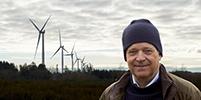
Henrik Stiesdal
Find out more about how Henrik Stiesdal has pushed the industry forward since the 1970s, and helped create thousands of jobs, including with the world-renowned "Danish Concept".
Stephen W. Dewar, Philip Watts and Frank Fish
Here is an example of a solution for a more sustainable future found in nature itself. Discover how the flippers of the humpback whale inspired this trio – a biologist, an aeronautical engineer and an entrepreneur – to invent a turbine with multiple applications, including wind power.Search patent information
Further wind power inventions can be found in the Y02 classification scheme for climate change mitigation technologies:
- Biofuels

Major advances have been made in the generation, storage and use of electrical energy from renewable sources such as sunlight and wind. Yet there remains a need for combustible fuels, at least for now. Traditionally, coal, natural gas and mineral oil have been the fuels of choice. However, not only are these fossil fuels finite. They are also releasing disastrous amounts of CO2 into the atmosphere, causing global warming to accelerate.
This explains the urgent need for alternative fuels produced using renewable sources. The main biofuels are currently biomass, biogas (containing between 50% and 75% methane), bioethanol and biodiesel. Other biofuels like biohydrogen or biobutanol are also on the rise.
Tremendous advances have also been made in biotechnology in recent decades in biotechnology, enabling specific microorganisms to be engineered to produce biofuels. Additional innovation in other fields has helped maximise the production of fuels from cheap and widely available sources such as waste streams from industry, agriculture or forestry (including straw, corn cobs, waste wood), municipal solid waste, wastewater and waste gases (e.g. CO or CO2).
Ultimately, the deployment of alternative fuels such as biofuels will depend on the future of combustion engines.Search patent information
Explore some of the biofuel inventions found in the Y02 classification scheme for climate change mitigation technologies:
Y02E50/00: Technologies for the production of fuel of non-fossil origin
Y02E50/10: Biofuels, e.g. biodiesel
Y02E50/30: Fuel from waste, e.g. synthetic alcohol or diesel
